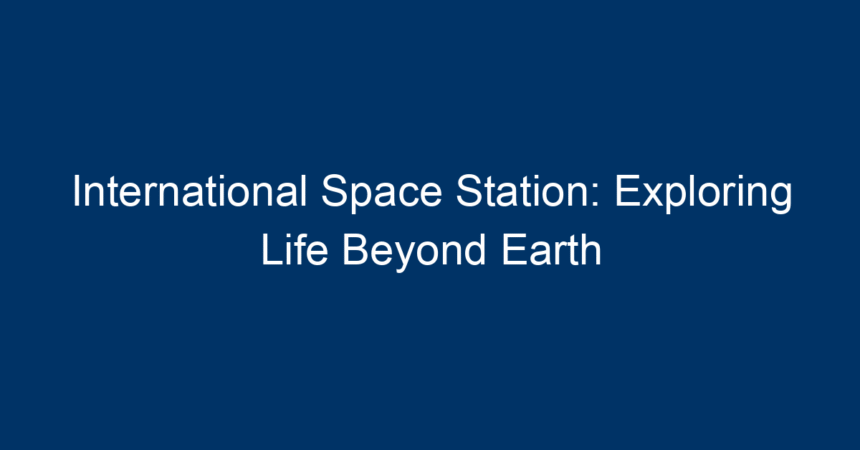The cosmos has always captivated humanity’s imagination, igniting dreams of exploration and discovery. Among the most remarkable endeavors in this quest for knowledge is the International Space Station (ISS). As a harmonious collaboration among various nations, the ISS serves as a living laboratory that not only enhances our understanding of science and technology but also paves the way for future exploration beyond Earth. In this article, we will delve into the significance of the International Space Station, the groundbreaking research conducted on board, and its role in preparing for life beyond our planet.
What is the International Space Station?
The International Space Station is a modular space station that orbits Earth at an altitude of approximately 420 kilometers (261 miles). Launched in 1998, it has become a symbol of international cooperation in space exploration, involving the contributions of five participating space agencies: NASA (United States), Roscosmos (Russia), JAXA (Japan), ESA (Europe), and CSA (Canada).
Structure and Functionality
The ISS consists of multiple interconnected modules that serve diverse functions, such as laboratories, living quarters, and docking ports for visiting spacecraft. Its advanced solar panels generate power, while its atmosphere is meticulously controlled to ensure the safety and comfort of the astronauts living aboard. This unique configuration allows for various scientific experiments that would be impossible to conduct on Earth due to gravity’s constraints.
Living and Working in Space
Life aboard the International Space Station presents a unique array of challenges and experiences. Astronauts aboard the ISS must adapt to microgravity, which affects daily activities like eating, sleeping, and exercising.
Daily Life
An average day for an astronaut on the ISS involves a rigorous schedule of research, exercise, and communication with mission control. Astronauts typically exercise for about two hours daily to counteract the muscle and bone loss associated with prolonged exposure to microgravity. Meals are carefully planned and packaged to ensure the crew receives the necessary nutrients, and they often enjoy a mix of rehydrated and thermostabilized foods.
Scientific Research
The ISS serves as a versatile research platform, allowing scientists to conduct experiments in various fields, including biology, physics, astronomy, and Earth science. Researchers investigate the effects of microgravity on biological organisms, develop new materials and pharmaceuticals, and study phenomena like fluid dynamics and combustion under conditions found in space.
Scientific Breakthroughs from the ISS
The International Space Station has produced groundbreaking scientific results that impact life on Earth and further our understanding of the universe.
Advancements in Medicine
One of the most significant breakthroughs from the ISS involves studies on cellular and molecular biology. Research into the effects of microgravity on human cells has provided insights into cancer research and drug development. For instance, scientists have discovered that some cancer cells grow differently in microgravity, offering new angles for treatment.
Earth Observation and Climate Research
The ISS also plays a critical role in monitoring Earth’s climate. Its unique vantage point allows for real-time observations of natural disasters, deforestation, and urban growth. Instruments onboard capture high-resolution images and data, aiding scientists in understanding climate change and its global effects.
Astrobiology and the Search for Extraterrestrial Life
Perhaps one of the most fascinating aspects of ISS research is its contribution to astrobiology. Experiments aboard the ISS aim to understand extremophiles—organisms that thrive in extreme conditions. These studies help scientists learn more about where life might exist beyond Earth, such as on Mars or the moons of Jupiter and Saturn.
Engineering Innovations from the ISS
The challenges of long-duration spaceflight inspire significant engineering advancements that benefit life on Earth. The International Space Station has been a testing ground for new technologies and systems.
Water Recovery and Filtration
One of the outstanding innovations developed for the ISS is advanced water recycling technology. Astronauts onboard rely on a complex system that purifies urine and other wastewater back into clean drinking water. This technology has applications for sustainable water management on Earth, especially in regions facing water scarcity.
Space-Grade Technologies
Numerous technologies developed for the ISS find their way into consumer products, from enhanced robotics used in surgery to advanced materials used in aerospace and automotive industries. The research conducted on the ISS encourages cross-disciplinary innovations that can lead to improved products and technologies in daily life.
The Future of the International Space Station
As the ISS approaches the end of its operational life, discussions about its future have gained momentum.
Commercialization of Low Earth Orbit
International agreements and partnerships are paving the way for the commercialization of activities in low Earth orbit. Private companies are exploring opportunities for research, manufacturing, and tourism, which could transform the landscape of space exploration.
Preparation for Mars Missions
The ISS serves as a critical stepping stone for future exploration initiatives, particularly missions to Mars. Research conducted aboard the ISS will provide vital data on the physiological effects of long-duration space travel, helping to prepare astronauts for the challenges they will face on missions to the Red Planet.
Conclusion: A Call to Action
The International Space Station stands as a testament to human ingenuity, collaboration, and the unyielding desire to explore the unknown. Its scientific discoveries have not only enriched our understanding of space but also enhanced life on Earth.
How You Can Get Involved
- Stay Informed: Follow updates from NASA and other space agencies to learn more about ongoing research aboard the ISS.
- Engage with Science: Encourage young minds to explore STEM (science, technology, engineering, and mathematics) fields, nurturing the next generation of scientists and engineers.
- Advocate for Space Exploration: Support policies and initiatives that fund and promote space research, ensuring that humanity continues to push the boundaries of what is possible.
By embracing the spirit of exploration embodied by the International Space Station, we can work together to better understand our universe and inspire future generations to look beyond Earth. The journey is just beginning, and the possibilities are limitless.




